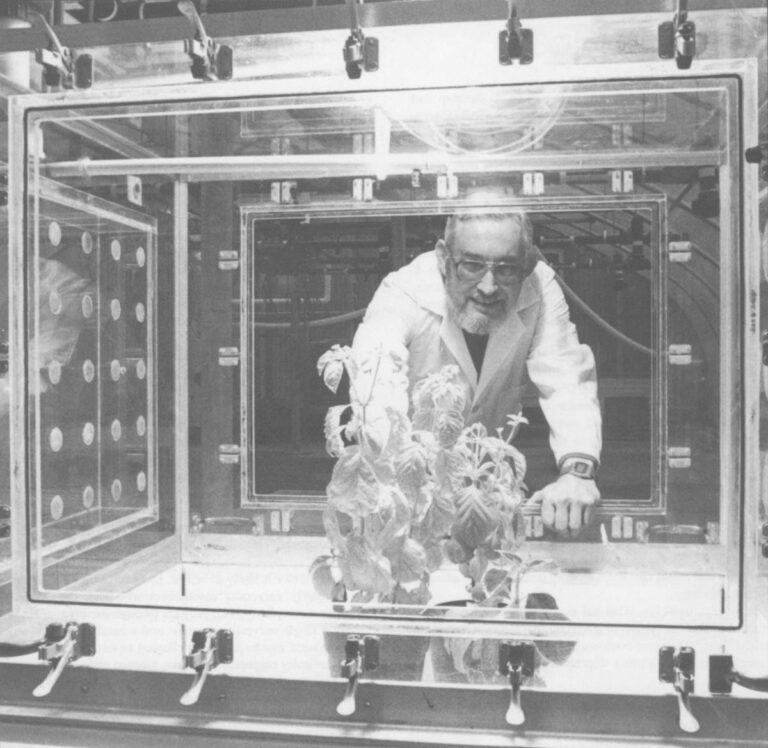The average new drug costs $80 million to develop and another $40 million to safety test before it passes federal scrutiny and reaches the market. A new agricultural chemical costs about $70 million to develop and $15 million to safety test.
In contrast, a seed company typically invests only half a million dollars to develop a new line of corn. And it is not required to spend anything on safety testing.
“Traditionally, our industry hasn’t spent infinite millions on all possible predictive safety tests until we’ve had good reason to think there could be a problem,” says Dr. Ronald L. Meeusen, manager of agricultural biotechnology at the Rohm & Haas Research Laboratories in Spring House, Pennsylvania. New varieties of corn, tomatoes, cattle or even agriculturally useful microorganisms bred by traditional methods or mutated by radiation or chemicals typically reach the market with little or no attention from government.
But the United States has taken a different approach to living creatures altered by recombinant DNA techniques.
In 1984, shadowed by a decade of public apprehension about genetic engineering and swayed by concerns of ecologists that some unique risk to the environment might be involved, the Reagan Administration decided to require federal oversight of all outdoor testing of recombinant organisms. It proposed to do this by bringing genetically engineered plants and microbes under the wing of existing laws covering the manufacture of toxic chemicals and movement of plant pests. To a deregulation-minded administration, this seemed a way to satisfy the political pressure for oversight while heading off new laws that might cost the nation its international leadership in biotechnology.
Ironically, however, what has emerged over the past three years is a complex system of oversight that requires months of deliberation, telephone-book scale paperwork and a level of expense and safety testing unprecedented in agricultural research.
For an academic scientist accustomed to contemplating the pH of caterpillar stomachs or the fatty acid composition of flax seeds, just finding a way into the system’s maze of acronyms can be daunting. Where you must go depends less on the character of your recombinant creature than on what you do to it and how.
For instance, if you take a microbe and add to it a gene from a bug of another genera, you must file a PMN with EPA under TSCA and hope for a 5E Consent Order.
If you plan to use the microbe as a pesticide, then you’re required to seek an EUP from EPA under FIFRA no matter what genetic tailoring you do.
Or perhaps you want to genetically alter a plant. If the gene or the plasmid (the ring of mobile DNA) you use to transfer it came from any bug the USDA considers a plant pest, you may need a permit from APHIS under the FPPA or the PQA before you plant. If you’re uncertain you might seek advice from the BEC staff or from OAB and its ABRAC.
The acronyms can be somewhat daunting even to people who run those initialed domains.
Over at BEC–the Biotechnology and Environmental Coordination staff of the U.S. Department of Agriculture (USDA) Animal and Plant Health Inspection Service (APHIS)–Director Terry Medley jokes that one of his first priorities was to find a way to deal with proliferating acronyms. So in the Old MacDonald tradition of agriculture, his staff created the Emergency Initial Examination Interpretation Office, or EIEIO.
Such humor is likely to be lost, however, on most scientists, particularly university researchers who lack the time and money to shepherd small projects through the system. So far, only a single university scientist and a handful of companies have passed muster and been allowed to test the performance of genetically engineered bacteria, tobacco and tomatoes out of doors under tight restrictions. Others have dropped or delayed projects, moved their testing overseas or, in a widely reported incident in Montana last summer, openly defied the federal regulations.
Results of the first round of field tests–including the illegal ones–have borne out early assessments that they posed little risk. The creatures have made no “escapes” and left no lasting impacts–that is, did not establish themselves as weeds or compete successfully with native microbes and colonize the fields.
Federal officials admit to an excess of caution in these early cases, largely for political rather than scientific reasons. They have methodically created “paper trails” in anticipation of lawsuits by anti-biotech activist Jeremy Rifkin.
In 1986 John A. Moore, assistant administrator for pesticides and toxic substances at the Environmental Protection Agency, rejected the advice of his agency’s Science Advisory Board and turned down a request by Monsanto to field test a recombinant microbe shown by the company’s studies to be harmless. He told the press that he had rejected the request mainly “to bolster public confidence” in his agency.
Moore acknowledges that some of these first requests probably endured unwarranted scrutiny. “It’s overkill,” he told the San Francisco Chronicle. “On the other hand, I think it’s probably a political reality that there has to be overkill with the first few things if only to convey to the public that there is somebody theoretically watching out for their interests.”

But last fall Moore told biotechnology industry leaders he believes there has been a shift in public perception: “I believe the public is developing a fragile confidence in the agency and its process.”
Now the administration is banking on that confidence as it attempts to shift its own approach to regulation. At both EPA and USDA, officials are planning to propose major changes in the system this spring, including a move to begin shifting oversight of some environmental releases to local committees and reducing the federal presence in academic research.
This pattern of prospective regulation–clamping tight restrictions on a technology before any actual hazards have been demonstrated, then modifying them with experience–was unwittingly set in motion by scientists themselves at the dawn of genetic engineering research.
In 1974, eminent molecular biologists called for a temporary, voluntary moratorium on certain recombinant DNA experiments until concerns about potential hazards could be considered. The result was a now-legendary international meeting of biologists at Asilomar, California, in February 1975. The scientists recognized quickly that their fears had been largely unfounded. But to their surprise the press and public embraced these fears, in some cities exaggerating what-if scenarios to near-hysterical proportions. The lingering public mistrust of the technology has kept decisions about genetic engineering in the political domain ever since.
In this climate, the somewhat arbitrary risk categories and containment schemes for genetically engineered organisms that grew out of Asilomar were institutionalized in 1976 into a set of guidelines administered by the National Institutes of Health Recombinant DNA Advisory Committee (RAC). These guidelines, which shaped the course of genetic engineering research through the rest of the decade, expressly prohibited any release of recombinant creatures into the environment. They were binding only on federally funded researchers, but the fledgling biotech industry agreed to follow them voluntarily.
As years passed and thousands of experiments produced no evidence of unique hazards that would set genetic engineering apart from mainstream biological research, the RAC guidelines evolved. By late 1981, oversight of 90 percent of recombinant DNA experiments had been returned to local groups called Institutional Biosafety Committees and the RAC recommended all mandatory guidelines be eliminated. However, fear of public backlash or a patchwork of state and local regulations led the committee to reverse that recommendation in February 1982. It also voted, however, to begin accepting applications for the release of lab-made organisms into the environment.
Within the next year, the RAC had approved three requests for small-scale field tests: two involving new varieties of corn, tomatoes and tobacco and the other frost-retarding bacteria. But those approvals had an unintended effect. They focused the attention of ecologists, activists, Congressmen and other federal agencies on the issue and set the stage for proposal in 1984 of a federal regulatory system more stringent in many ways than the initial guidelines.
In the summer and fall of 1983, events heated up. The House held hearings. Ecologists, many of them startled to find that genetic engineering had progressed so rapidly from lab to field, expressed concerns. Congressmen pondered whether new laws were needed. The EPA signaled its intent to take charge of regulating the industry and other agencies began to look for a piece of the action. Molecular biologists and the biotech industry urged that oversight be kept flexible, at the level of guidelines rather than laws and formal agency rules.
Then Rifkin sued the RAC, claiming that an environmental impact statement should have been prepared before the guidelines were changed to allow outdoor releases. Federal Judge John J. Sirica stunned the industry and even Rifkin in May 1984 when he issued an injunction to halt RAC-approved releases, agreeing proper procedures had not been followed.
So in the spring of 1984, with releases halted, Congress unhappy, industry nervous and a turf struggle looming among federal officials, the White House called 14 agencies together to develop a plan. A draft proposal was circulated in December 1984. No one seemed pleased. On June 26, 1986 a revised version, the Coordinated Framework for the Regulation of Biotechnology, was published in the Federal Register and continues in force today.
The administration based its plan on two premises:
- That no new laws were needed to regulate this field.
- That individual products should be regulated or not according to their own merits, not because of the process by which they were made.
This second premise, however, has proven politically unapproachable. EPA and USDA give special scrutiny to the living products of genetic engineering, especially those carrying genes from a different genera or species.
Scientists overwhelmingly consider this unjustified. Indeed, last September a panel of the National Academy of Sciences released a report concluding there is “no evidence that unique hazards exist either in the use of (recombinant) DNA techniques or in the movement of genes between unrelated organisms.”
“Politically, it doesn’t work to ignore process,” says Dr. David Kingsbury, an assistant director of the National Science Foundation and an architect of the current framework. “We know we’re over-regulated. That’s the insanity of the political environment in which we’re working.”
Under the current system EPA essentially regulates all releases of recombinant microbes, and USDA all plants. USDA also oversees testing and marketing of animal vaccines containing live genetically engineered viruses. The Food and Drug Administration will do the same for human vaccines.
EPA’s authority comes from two laws: the Federal Insecticide, Fungicide and Rodenticide Act (FIFRA) and the Toxic Substances Control Act (TSCA).
Under FIFRA, the producer of a new pesticide is required to show EPA that the substance does not cause “any unreasonable risk to man or the environment” before it can be registered for sale. Until 1984, a pesticide being tested on a plot smaller than ten acres did not require a permit, so most pesticides–including the 13 bacteria, viruses, fungi and protozoa now approved for use in agriculture, forestry and mosquito control–did not come under EPA scrutiny until they were ready for commercial sale. That year EPA began requiring notification of all field trials of microorganisms. By last summer it had received 18 such notifications, but only the three that involved genetic engineering were required by the agency to apply for a full paperwork-intensive Experimental Use Permit (EUP).
TSCA requires that companies file a pre-manufacturing notice giving the government 90 days to review the health and environmental effects of a new chemical before manufacture or importation. All genetically engineered microbes not intended for use as pesticides are now classified as chemicals under TSCA. Like FIFRA, TSCA formerly exempted small releases of chemicals into the environment during research and development. Now, however, any researcher who wants to test recombinant microbes outdoors must file a pre-manufacturing notice. Unlike FIFRA, TSCA puts the burden on the agency to prove that a chemical presents an unreasonable risk–a provision the government will seek to amend this spring.
USDA’s APHIS until 1984 was involved only in regulating the import or interstate transport of agricultural pests under the Plant Quarantine Act and the Federal Plant Pest Act. Now it also regulates any local release of potential pests. And it regards plants containing recombinant DNA as potential agricultural pests if any of the genetic material involved came from a pest. Because the most common tool for getting new genes into plants is a disabled plasmid–the Ti plasmid–obtained from a bacteria that causes plant tumors, APHIS now effectively “captures” all recombinant plants. Plant scientists consider it impossible for this bit of microbial DNA to turn a corn or tomato plant into a pest, and some groups are considering petitioning APHIS to exempt the Ti plasmid from its pest list.
Industry, for all its frustration with this ponderous system, is curiously protective of it and consistently opposes new legislation. Meeusen calls it “a pain in the rump” but not “overly burdensome.” It does provide certainty, a federal stamp of approval and protection from procedural lawsuits.
Rifkin has already challenged the Coordinated Framework unsuccessfully in court, but is still threatening to sue individual authorities such as TSCA.
Neither ecologists nor mainstream environmental groups are overjoyed with the regulatory scheme, but most feel they can work within it to assure that releases get adequate scrutiny.
Congress also remains uneasy, but despite numerous hearings and the introduction of more than a dozen bills over the past decade, has not yet come close to passing any new statutes.
Undoubtedly the group most troubled by the regulatory framework today is university scientists. Some in government, as well as, industry, are worried that burdensome federal oversight of university research–the source of basic concepts on which industry thrives–will cripple U.S. agricultural biotechnology.
“If an academic scientist who wants to do an experiment has to do $100,000 worth of preliminary studies to get a permit, he’s not going to do it,” says Dr. Steven Lindow, a University of California Berkeley plant pathologist who, after five years of delays, was permitted to field test his frost-retarding bacteria on potatoes last summer. “The data requirements are too great, and the granting system doesn’t support that kind of work.”
EPA and USDA officials say their goal is to keep the regulatory system flexible. Proposals now in the works will spell out more precisely what the laws cover and what data is required for risk assessment. Part of the task involves redefining words like “intergeneric” and “pathogen” that can change the scope of the regulations.
“Defining ‘pathogen’ is like the Supreme Court defining ‘pornography,’” says EPA’s Moore. “We all know what we mean when we see it, but putting it in words is another thing.” EPA has taken heat, for example, for proposing to define as a pathogen any virus or organism that causes disease in any other organism. Researchers worry this would mean that even a bug that receives a gene from a microbe that makes another microbe sick would be slated for a higher level of scrutiny.
Key proposals expected out soon would also move the regulatory system closer to the spirit and efficiency of the original advisory committee by decentralizing oversight of small-scale research.
USDA’s Office of Agricultural Biotechnology has just formed ABRAC–the Agricultural Biotechnology Research Advisory Committee–to provide guidance for federally funded recombinant DNA work in agriculture. Following the pattern, ABRAC is expected to turn most of the responsibility over to local Institutional Biosafety Committees. Whether a university scientist with a recombinant tomato will be able to avoid the federal government and seek approval for planting from his local biosafety committee is the subject of an ongoing struggle in the agriculture department.
EPA is also taking a cue from the success of campus biosafety committees. The agency plans to set up a system of Environmental Biosafety Committees that would be certified to handle oversight of some as-yet-unspecified categories of releases. Moore describes them as “a surrogate agency presence” and suggests they may be the only way to cope successfully with the hundreds of requests for environmental releases expected in the next two years.
©1988 Yvonne Baskin
Yvonne Baskin, a free-lance science writer, is reporting on the release of genetically engineered organisms into the environment.




